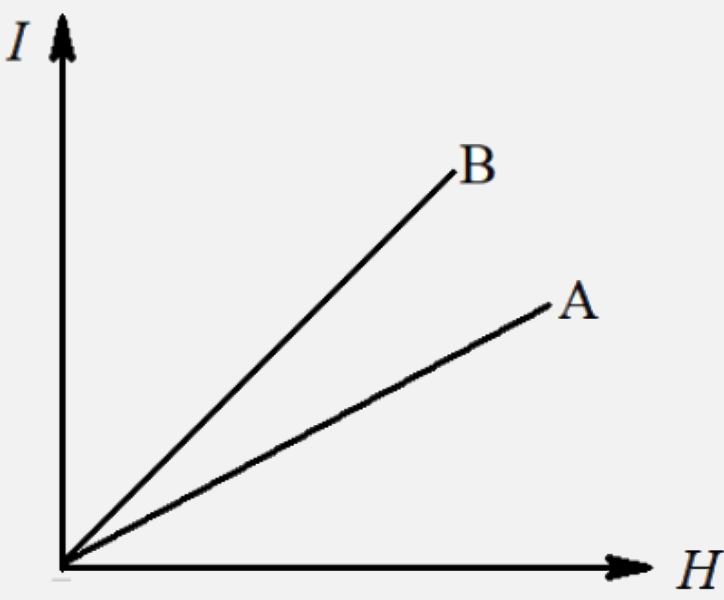The variation of the intensity of magnetisation (l) with respect to the magnetising field (H) in a diamagnetic substance is described by the graph.
OC
OD
OA
OB
The correct Answer is:A
To solve the problem regarding the variation of the intensity of magnetization (I) with respect to the magnetizing field (H) in a diamagnetic substance, we can follow these steps:
Step 1: Understand the Relationship
The intensity of magnetization (I) in a diamagnetic material is related to the magnetizing field (H) through the equation:
I=χH
where χ is the magnetic susceptibility of the material. For diamagnetic substances, χ is negative and has a very small magnitude.
Step 2: Analyze the Graph
In the graph provided, we need to identify the regions where the intensity of magnetization (I) is plotted against the magnetizing field (H). The graph will show a linear relationship, but since it is a diamagnetic substance, the slope will be negative.
Step 3: Identify Key Points
From the graph, identify the points that represent the relationship:
- Points A and B are in the positive region of the graph.
- Points C and D are in the negative region of the graph.
Step 4: Determine the Slope
The slope of the line in the graph represents the magnetic susceptibility (χ). Since we are dealing with a diamagnetic substance, the slope will be negative and very small in magnitude.
Step 5: Compare Slopes
Among the points identified, we need to find the line segment that has the smallest negative slope. This will be the segment with the least steepness in the negative direction.
Step 6: Conclusion
From the analysis, we find that the line segment from point O to point C has the smallest negative slope, indicating the least susceptibility in the negative direction. Thus, the correct answer to the question is option A, which corresponds to the line segment OC.
Summary of the Solution
- The relationship between I and H is linear and negative for diamagnetic substances.
- The slope indicates the magnetic susceptibility, which is negative and small.
- The line segment OC has the smallest slope, confirming it as the correct answer.
The intensity of magnetization (I) in a diamagnetic material is related to the magnetizing field (H) through the equation:
I=χH
where χ is the magnetic susceptibility of the material. For diamagnetic substances, χ is negative and has a very small magnitude.
In the graph provided, we need to identify the regions where the intensity of magnetization (I) is plotted against the magnetizing field (H). The graph will show a linear relationship, but since it is a diamagnetic substance, the slope will be negative.
From the graph, identify the points that represent the relationship:
- Points A and B are in the positive region of the graph.
- Points C and D are in the negative region of the graph.
The slope of the line in the graph represents the magnetic susceptibility (χ). Since we are dealing with a diamagnetic substance, the slope will be negative and very small in magnitude.
Among the points identified, we need to find the line segment that has the smallest negative slope. This will be the segment with the least steepness in the negative direction.
From the analysis, we find that the line segment from point O to point C has the smallest negative slope, indicating the least susceptibility in the negative direction. Thus, the correct answer to the question is option A, which corresponds to the line segment OC.
- The relationship between I and H is linear and negative for diamagnetic substances.
- The slope indicates the magnetic susceptibility, which is negative and small.
- The line segment OC has the smallest slope, confirming it as the correct answer.
Topper's Solved these Questions
- MAGNETISM AND MATTER BOOK - AAKASH INSTITUTE ENGLISHCHAPTER - MAGNETISM AND MATTER EXERCISE - ASSIGNMENT (SECTION A)
36 Videos
- MAGNETISM AND MATTER BOOK - AAKASH INSTITUTE ENGLISHCHAPTER - MAGNETISM AND MATTER EXERCISE - ASSIGNMENT (SECTION B)
24 Videos
- MAGNETISM AND MATTER BOOK - AAKASH INSTITUTE ENGLISHCHAPTER - MAGNETISM AND MATTER EXERCISE - Assignment Section D (Assertion- Reason Type Questions)
8 Videos
- LAWS OF MOTIONBOOK - AAKASH INSTITUTE ENGLISHCHAPTER - LAWS OF MOTIONEXERCISE - Assignment (SECTION-D) (Assertion-Reason Type Questions)
15 Videos
- MECHANICAL PROPERTIES OF FLUIDSBOOK - AAKASH INSTITUTE ENGLISHCHAPTER - MECHANICAL PROPERTIES OF FLUIDSEXERCISE - SECTION - J
9 Videos
Similar Questions
Intensity of magnetisation is
View SolutionThe following figure shows the variation of intensity of magnetisation I versus the applied magnetic field intensity H, for two magnetic materials A and B

Which of the material have a larger susceptibility for a given field at constant temperature?
View SolutionThe following figure shows the variation of intensity of magnetisation versus the applied magnetic field intensity, H, for two magnetic materials A and B :
(a) Identify the materials A and B.
(b) Why does the material B, have a larger susceptibility than A, for a given field at constant temperature?

View SolutionThe variation of magnetic susceptibility (χ) with temperature for a diamagnetic substance is best represented by
View SolutionThe ratio of magnetisation I to the magnetic field intensity H is
View SolutionIf the magnetising field on a ferromagnetic material is increased, its permeability is
View SolutionIf the magnetising field on a ferromagnetic material is increased, its permeability is
View SolutionThe dimensional formula for magnetising field H is
View SolutionThe ratio of mass of a diamagnetic substance in a magnetic field to its actual mass
View SolutionShow diagrammatically the behaviour of magnetic field lines in the presence of :
(i) Paramagnetic and
(ii) Diamagnetic substance, How does one explain this distinguishing feature ?
View Solution
